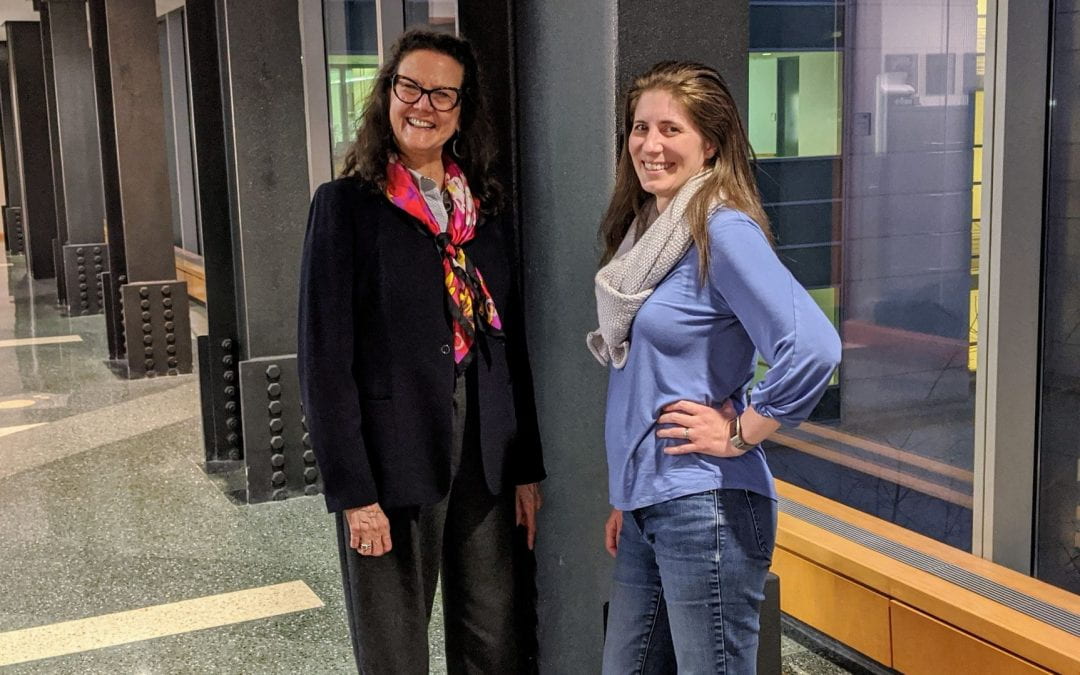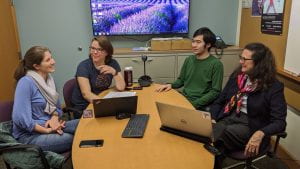The rampant proliferation of plastic in the environment, one of the world’s most widely used materials, is a massive and growing concern. Over the past 50 years, the world has produced 8 billion tons of plastic. Less than half is reused, or recycled into new items. The remainder has accumulated in landfills, oceans, and beaches, and found its way into our food chain and drinking water. If the trend continues, experts predict that by 2050 the ocean will contain more plastic waste (by weight) than fish.
Monica Olvera de la Cruz, Lawyer Taylor Professor of Materials Science and Engineering and Chemistry, and Danielle Tullman-Ercek, Associate Professor of Chemical and Biological Engineering, are using a new Cornew Innovation Award from the Chemistry of Life Processes Institute (CLP) at Northwestern, to turn the tide on plastic through upcycling. The nascent process involves deconstructing plastic waste back into its basic molecular components, in an environmentally friendly way, with the goal of ultimately reducing the amount of single-use plastic produced globally.
Upcycling vs. Recycling
“Recycling implies a traditional process where plastic is melted down with whatever contaminants are there. The result is always lower quality plastic. Whereas, upcycling makes it just as good as the original product,” Olvera de la Cruz said.
One of the most common forms of plastic is polyethylene terephthalate (PET), a by-product of petroleum production. The basic building blocks of PET are ethylene glycol and terephthalic acid, organic molecules that combine to form polymer chains called monomers that are heated up and molded into products. PET is used to make synthetic fibers for clothing and textiles (polyester), as well as plastic bottles and containers. Designed to be durable and resistant to degradation, 96 percent of plastic bottles and containers made in the US are comprised of the PET with an average lifespan of 450 years.
The path to chemically upcycling of PET plastic waste opened up in 2016 when a team of Japanese researchers discovered a new species of bacteria, Ideonella sakaiensis, near a bottle-recycling facility. They found that these bacteria metabolize PET through secretion of a naturally occurring enzyme, or PETase, which degrades PET into its basic components.
The Challenge
Chemical upcycling poses a considerable scientific challenge. The current process requires significant energy, harsh chemicals, and is slow. Current PETase applications take days to a week to achieve measurable PET degradation.
The US Department of Energy’s Basic Energy Sciences Program held a Roundtable on Chemical Upcycling of Polymers last April to discuss new approaches to the problem. Olvera de la Cruz, is a member of the program’s Advisory Committee. The group identified several high priority opportunities for transforming plastic waste into higher value fuels, chemicals, and materials.
Inspired by the challenge, Olvera de la Cruz and Tullman-Ercek, who often cross paths in Silverman Hall, seized on the opportunity to collaborate. An expert in the statistical mechanics of soft materials, Olvera de la Cruz studies the interactions of polymers and the physical forces involved in breaking molecular bonds or optimizing polymers for various applications. Tullman-Ercek is skilled in optimizing enzymes for industrial purposes.
“We have these pieces of the process that we know,” Tullman-Ercek said. “If we could make the enzyme work better and faster, then we could make enzymatic degradation an industrially viable process.”
Funding from the CLP-Cornew Award has kick-started the collaborators’ multi-disciplinary project, which combines enzyme synthesis, plastic processing and modification, and random polymer design to enhance the enzymatic activity of PETase. Their approach involves encapsulating the enzyme with a polymer, a technique that originated in Olvera de la Cruz’s lab, to allow this water-based protein to align with, and act on, the oil-based the plastic molecules. Encapsulation will also preserve enzyme activities under the elevated temperatures needed to quickly degrade PET. In addition, Tullman-Ercek will genetically engineer the enzyme to create a modified enzyme that works more quickly on PET.
“We are going to direct its evolution towards what we need. It’ll happen faster than it would happen spontaneously in nature— a couple of years instead of a few decades,” Tullman-Ercek said. “We’re going to apply everything we learned with other enzymes and import that over, but we’re going to encounter challenges. So that’s, where our expertise comes in— overcoming whatever challenges arise.”
Data from these pilot experiments will be used to support the team’s application, with Northwestern University expert in polymers and collaborator John Torkelson, for various federal funding opportunities in this topic. Their long-term goal is to bring in other investigators to form a large, interdisciplinary team of engineers, chemists and biologists to direct their collective skills and knowledge towards tackling the global plastic problem.
“This project is a perfect example of how Institute researchers from very different areas work together to take on really big problems,” Thomas O’Halloran, Founding Director of Chemistry of Life Processes Institute, said. “I’m excited to see where their collaboration takes them.”
About the CLP-Cornew Innovation Awards
CLP-Cornew Innovation Awards, made possible by the generosity of Chemistry of Life Processes Institute Executive Advisory Board (EAB) members, support promising interdisciplinary teams of CLP researchers in early stage development of high-risk, high-reward research projects with the potential to make significant impact.
Since 2008, the EAB has made 25 awards, worth a total of $1.07 million, to CLP faculty teams in pilot funding. Cornew Awards have resulted in 42 publications and more than $22 million in new external funding to advance these projects opening up critical areas of transdisciplinary research and resulting in discoveries that impact human health and disease.
by Lisa La Vallee
Featured image above (left-right): Monica Olvera de la Cruz and Danielle Tullman-Ercek

